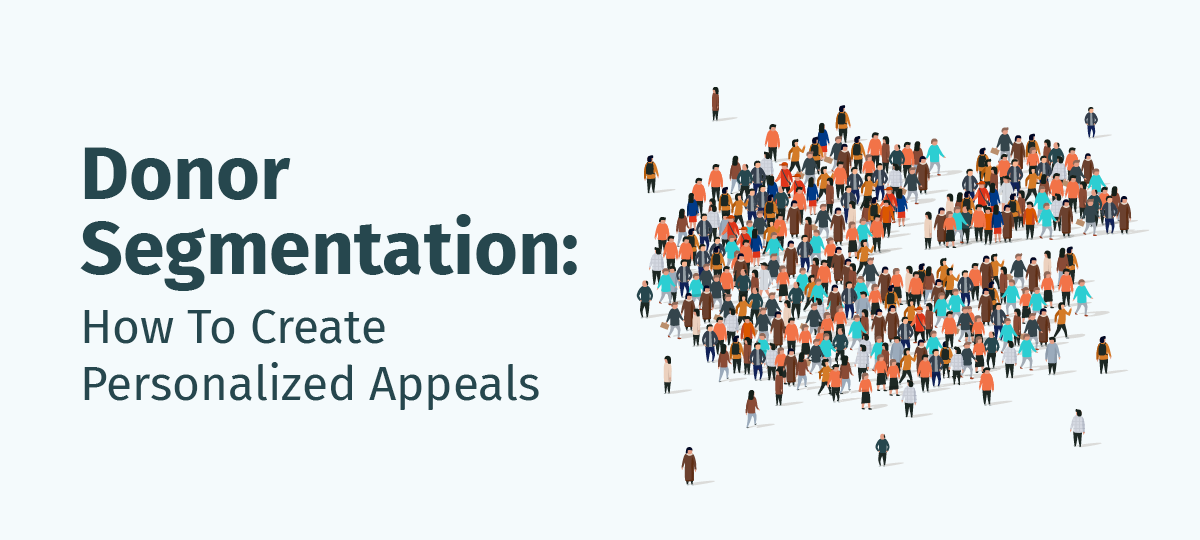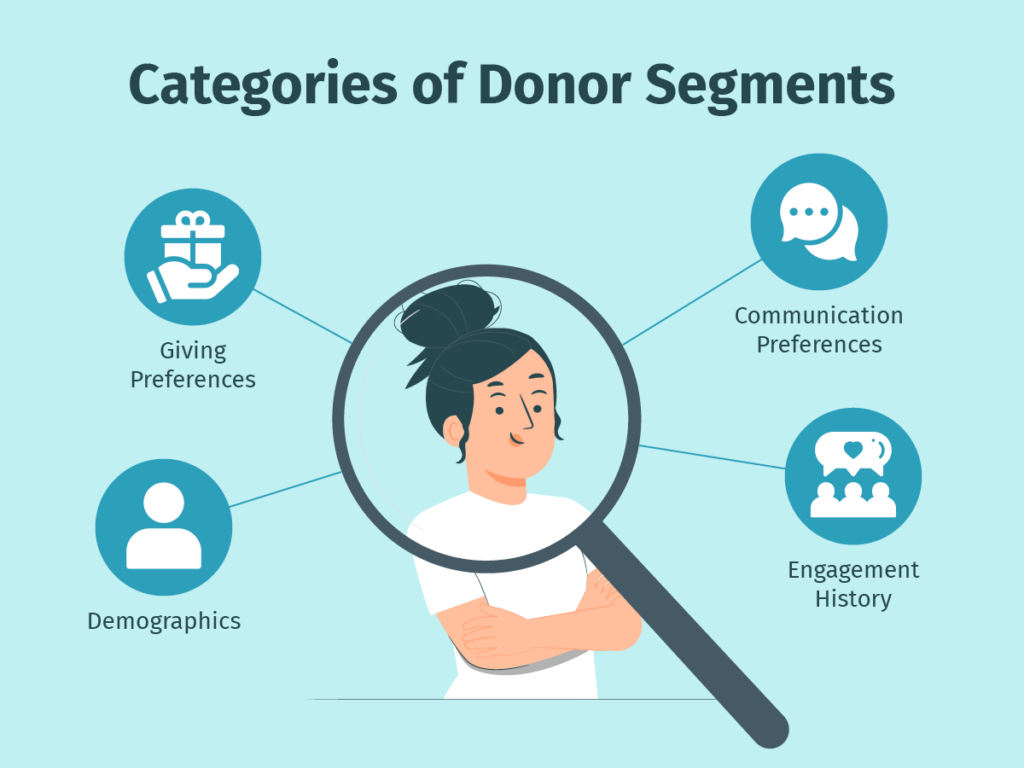As a nonprofit professional, you’re always searching for the best ways to improve your fundraising efforts and maximize the use of data captured from your campaigns . And with donor acquisition costing 10 times more than retention, you know how crucial it is to secure long-term support.
Enter donor segmentation. This method of leveraging your donor data can help your team target the right audience for your communications and deepen existing supporter relationships. In this guide, we’ll explore how your organization can use segmentation by covering the following topics:
- How to create donor segments
- 4 categories of donor segments
- Benefits of donor segmentation for fundraising appeals
- How to personalize fundraising appeals with segmentation
Are you ready to make donors feel seen and inspired with communication tailored specifically to them? By leveraging the tips in this guide, you’ll increase the chances that supporters will act on the appeals you send their way!
How to create donor segments
Donor segmentation for nonprofits involves dividing your supporter base into smaller subcategories based on shared characteristics. When you identify similarities among your donor population, you can build your outreach and marketing strategies around those groupings rather than relying on general messages for your broad donor base.
To help develop segments, you can collect data from your auction website , social media metrics, or any other source of donor information. With this data, you can start categorizing donors according to different types of segments.
4 categories of donor segments
You’ll need to consider the unique characteristics of your donor base to create segments, but there are a few common categories that work for most nonprofits.
Demographics
Your team will inevitably collect basic demographic data from prospect research , online giving forms, event registrations, and other interactions with donors. Categories include:
- Age
- Gender
- Parental status
- Marital status
- Retirement status
This information can help your nonprofit determine the types of donors your organization attracts. For example, are your supporters local or worldwide? How will this insight translate into how your organization makes its fundraising appeals to these groups?
Giving preferences
Segmenting your donors by giving preferences enables your nonprofit to make the donation process easy and accessible for your specific groups. A few popular methods of giving include:
- Cash
- Check
- Credit or debit card
- In-person
- Online
- Direct mail
- Text-to-give
You can also use this information to diversify giving opportunities for each fundraising campaign, appealing to as many segments as possible. For example, Snowball’s guide to text-to-give fundraising notes that mobile giving campaigns can easily run concurrently with other initiatives. This way, you can ensure your fundraising opportunities appeal to donors with varying giving preferences.
Communication preferences
Along with sending the right content, your team should also leverage the right communication channels. Segmenting donors by their communication preferences enables you to determine the best way to reach them, such as:
- Text
- Social media platforms
- Direct mail outreach
Also, consider your website’s engagement metrics to reach those who have yet to subscribe to direct communications. This way, you can meet donors where they’re most likely to interact with your material.
Engagement history
Understanding how your supporters engage with your organization is crucial to strategizing your appeals. For example, you won’t want to ask someone who volunteers their time and makes small donations for a much larger gift. Here are a few categories that your team should consider:
- Event attendance as a participant or volunteer
- Gift history, including amounts and campaigns
- Social media engagement, such as likes or shares
You can look for more similarities to break these categories down even further by using several metrics in tandem. For example, you might identify college-aged supporters who prefer to give in person. Supporters who fit into this segment might be interested in a college campus fundraising event, which can direct your future event planning ideas.
With these categories in mind, your team can determine what inspires each person to donate to your organization and create meaningful appeals.
Benefits of donor segmentation for fundraising appeals
Donor data can help your team understand pertinent information about how your organization and supporters interact with each other. Thus, segmentation will strengthen your asks and streamline your communications so no appeal goes unnoticed.
Here are just a few benefits of donor segmentation and personalized fundraising appeals:
- Using the right platform for marketing: Segmenting your donor audience by engagement habits and communication preferences enables your nonprofit to develop a strategy for effectively marketing to each subgroup. For example, you can use data like follower counts and engagement metrics to understand which social media platforms are best for attracting engagement with your content. You can also leverage free nonprofit marketing tools to enhance your material, like Canva or Google Analytics. Other free tools, such as MailChimp, can further help with segmentation by using your pre-made audience segments to create tailored messages for each group.
- Asking the right audience for support: Engagement habits and giving histories reveal which appeals to make to which target audience. For example, you may deliver customized event invites only to those who have historically attended your auctions and galas. Or, you might personalize your fundraising appeals for specific goals that have previously motivated certain supporters to give their time or money.
- Long-term strategic value: As supporter preferences, technology, and philanthropic culture change over time, your segmentation strategies and communications will also have to adapt. Concrete segmentation strategies allow you to track marketing and appeal performance tied to specific segments. Over time, you can adjust your strategy based on that performance. Plus, proactive data management and segmentation help you stay on top of changing trends.
Through specific and individualized appeals, donor segmentation also strengthens the current relationships you have with your supporters. This not only helps your team raise funds more effectively but improves donor engagement and retention over time.
To fully reap the benefits of segmentation, your nonprofit must practice data hygiene. According to NPOInfo, this means verifying data, removing unusable records, and appending new data to keep your database free of errors. Regular data reviews and standardized entry protocols can provide your team with new and recent data to glean insights for improving your current segmentation strategies.
How to personalize fundraising appeals with segmentation
To help donors feel like active partners in achieving your mission, you’ll need to personalize your fundraising appeals and communications with them in the following ways:
- Address recipients by name. When addressing a piece of mail or writing the introduction to an appeal, use donors’ names. This will establish recognition for their efforts and potentially a long-term relationship going forward.
- Provide suggested donation amounts. Group donors into segments based on their average giving amount and ask for suggested donation amounts that align with each segment’s giving capacity. For example, wealth indicators may identify donors willing to give major gifts. Just be sure to offer a custom amount option so donors have the flexibility to give lower or higher amounts.
- Appeal to donors’ giving motivations. Create segments based on donors’ engagement histories and cater your communications to their giving motivations. For example, tell a beneficiary’s story in an appeal to donors who previously gave to a campaign that supported the individual. Share the impact of their previous gift and explain what they can do to continue supporting your nonprofit’s work.
The right fundraising software can integrate with your CRM to automatically populate recipients’ names into messages and track donors’ giving and engagement habits. If you invest in a platform with donor engagement tools, you can even create segmented supporter lists using the same tool that manages your fundraisers, keeping all your data collection and insights in the same place.
Overall, implementing donor segmentation and personalization in your organization’s fundraising appeals is an effective and innovative way to optimize your communication and promotional strategies. With this, you’re likely to increase engagement, fundraising, and improvements in every area of your organization.
About the Author: John Killoran
John Killoran is an inventor, entrepreneur, and the Chairman of Clover Leaf Solutions, a national lab services company. He currently leads Clover Leaf’s investment in Snowball Fundraising, an online fundraising platform for nonprofit organizations.
Snowball was one of John’s first public innovations; it’s a fundraising platform that offers text-to-give, online giving, events, and peer-to-peer fundraising tools for nonprofits. By making giving simple, Snowball increases the donations that these organizations can raise online. The Snowball effect is real! John founded Snowball in 2011. Now, it serves over 7,000 nonprofits and is the #1 nonprofit fundraising platform.

